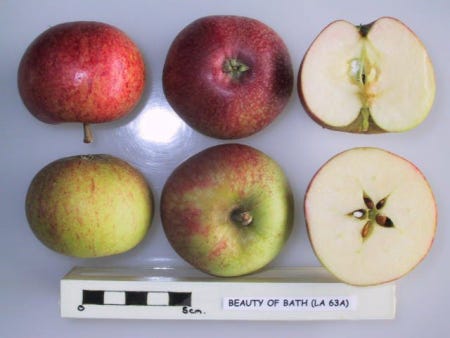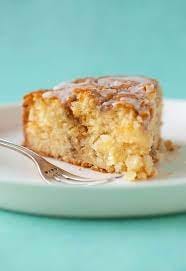Beauty in name only. This apple isn't
A recipe for Apple cake

In our family garden when I was young grew two apple trees. Beautiful in spring with pale pink blossoms floating along the boughs, their gnarled branches gave them first-rate potential for supporting a treehouse which, because the fruits the blossoms developed into were horrible, is what my sister and I pleaded for. But my father wouldn’t stand for this proposal: apple trees were for eating from, not for living in.
In any other case, we would have agreed. But in this particular, the apples these two delivered were Beauty of Bath, and we hated them. A relatively recent addition to the orchard, it’s an early cropping cultivar that was propagated in 1864 by nurseryman George Bradley in Bath and once was extremely popular. Though never with my sister and me.
Beauty of Bath is an enthusiastic cropper, which we regretted. While the apples were sweet and juicy, with that curious acetone flavour of mouth-puckering Pear Drop sweeties, their flesh was doughy. Eating them was like biting into fruity cotton wool. Or mashed potato flavoured with Diorissimo.
Whatever you believe Eve was guilty of guzzling (most likely a pomegranate), the world's first natural orchards were probably date orchards flourishing round oases. Originally, in both the East and the West, cultivated orchards were the privilege of the wealthy. They evolved over the course of thousands of years, as civic developments expanded to include monasteries and the private gardens of the rich. The discovery in the Amazon of hundreds of geometric earthworks and ring ditches containing traces of pollen and charcoal has given rise to a theory that before Christopher Columbus arrived, the forest was populated by farming communities (and by warriors including a fierce band of female warriors called Amazons), who were cultivating grains, vegetables and fruits to feed their communities.
One of the earliest known cultivators of vegetables and fruits was Feng Li, a Chinese diplomat living around 5000 BC. He grew a variety of fruits, including apples, as a commercial enterprise, using them for bartering goods and services.
For centuries, fruit cultivation was more about indulging the whims of the wealthy than feeding the needy. But as populations expanded, fruit trees spread, through both deliberate and natural propagation, to open fields and wild landscape with fruit free for the picking by one and all.
In our house, it was hard to keep up with the number of Beauty of Bath apples that matured on the trees as early as July, going on, it seemed to us, interminably. Generally, before my sister and I could be organised to pick them off the branches, they had dropped to the ground where their bruises would attract swarms of wasps. Those we did manage to harvest, we were instructed to wrap up in newspaper and store in the shed to eat over the winter. Eating them is what our parents insisted we did since nature’s bounty should never be allowed to go to waste.
Beauty of Bath were just about acceptable over the summer. But during that first winter following our recycling efforts with the Street of Shame's daily publications, we discovered that Beauty of Bath is not an apple that will keep. In the dark and cool of the shed, the wrapping sheets of newspaper grew together in a mold-covered sludge that soaked the cardboard boxes, out of which the rotted apples flopped to the floor. Unshrouded from their pages of the dailies and Sundays, they were mush.
So the following summer, when my father had joined us in resenting the presence of Beauty of Bath in the fruit bowl, my mother turned them into this apple cake, nice slightly warm with a scoop of vanilla ice cream or cold with cream.
You may wonder why I propose the recipe for Apple Cake for a month of spring. But the new season's bounty of berries and fruit are not yet in the supermarkets. (If you Comment about the available of fruit from countries I really wish I were backpacking around right now, I shall ignore you.) And producers in farmers markets are offloading the last of the apples they have been storing in readiness this new month for local strawberries, raspberries, cherries, and more. Besides, it may very well be that you, too, have apples - unlikely to be Beauty of Bath - stored in newspaper in some cellar or shed. Even if you don’t, you could be expecting company over to eat sometime, now we're meeting up again in warming weather. You might even be celebrating the Queen’s Jubilee…And this cake is very quick to make, doesn’t need a mixer, and so easy you can delegate children to cook it for you.
235g/8¼ oz apples (Golden Delicious, Beauty of Bath - haha, or other), peeled, cored and cut into 2½cm/1in cubes
300g/10½ oz plain white flour, sifted
¾ teaspoon bicarbonate of soda
¾ teaspoon each of salt, cinnamon and ground cloves
¼ teaspoon fresh ground nutmeg or ½ tsp pre-ground nutmeg
275g/9¾ oz light brown sugar
250m/8½ fl oz vegetable oil
2 eggs
1½ teaspoon vanilla extract
100g/3½ oz walnuts, chopped (optional)
Icing sugar for dusting
Preheat oven to 180C/350F.
Grease and line a 21cm/8ins springform cake pan.
Place flour, baking soda, salt and spices in a large bowl and whisk to combine.
Whisk oil and sugar in a bowl, then whisk in eggs and vanilla.
Pour the wet ingredients into the dry and mix with a wooden spoon until JUST combined. Fold in the apple cubes. If you’re adding the chopped walnuts, do it now.
Pour the batter into cake pan.
Bake for 50 minutes - 1 hr. Check at 50 minutes - it is cooked when a skewer inserted into the centre comes out clean.
Cool for 10 minutes before turning out onto a rack to cool. Dust with icing sugar if using, then serve. This is a very moist cake so strictly speaking doesn't need cream. But I would serve it with creme fraiche or a creme anglaise. It’s best served warm or at room temperature.




